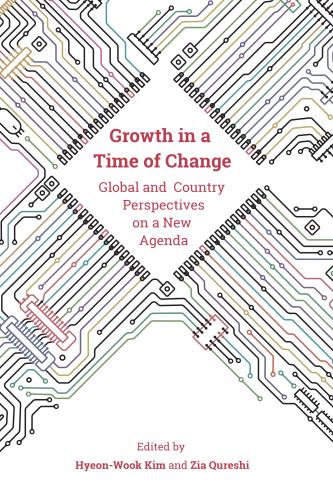This brief is part of the Brookings Blueprints for American Renewal & Prosperity project.
Digital technologies have dazzled but not delivered the expected dividend in higher aggregate productivity growth. Inequality has been rising. The COVID-19 pandemic can reinforce these dynamics as it accelerates digital transformation. Today’s innovation economy must be broadened to disseminate new technologies and productive opportunities among smaller firms and wider segments of the labor force. Innovation must be democratized. There are three key areas for policy action:
- Competition policy should be revamped for the digital age. Antitrust enforcement should be beefed up, supported by updated laws and guidelines. Funding for the Federal Trade Commission (FTC) and the Department of Justice Antitrust Division should be increased to offset years of decline. Issues revolving around data, digital platforms, and rising market domination by tech giants must be addressed. To tackle this new agenda, the regulatory framework led by the FTC should be strengthened, including considering the establishment of a new federal regulatory unit for digital markets.
- The innovation ecosystem should promote wider diffusion of new technologies. The century-old patent system should be reviewed in light of today’s realities. Public investment in R&D should be revived to strengthen support for innovation that serves broader economic and social goals rather than the interests of narrow groups of investors. The Small Business Innovation Research and the Small Business Technology Transfer programs should be strengthened and their effectiveness enhanced by shifting more resources to early-stage awards to small and young firms.
- Investment in upskilling and reskilling the workforce should be boosted. Scaling up the availability and quality of continuing education should receive increased support under the Higher Education Act and the Workforce Innovation and Opportunity Act. Workers’ access should be facilitated through mechanisms such as Lifelong Learning Accounts. The potential of technology-enabled solutions should be more fully exploited, supported by a stronger foundation of digital infrastructure and digital literacy. Support for universal connectivity should receive priority in congressional deliberations on an infrastructure bill.
An agenda to enable broader participation of firms in the innovation economy and build workforce capabilities that complement new technology can deliver both more robust and more inclusive economic growth. It can reduce inequality and economic insecurity more effectively than fiscal redistribution alone.
Challenge
Ours is an era of innovation embodied in dazzling new technologies. It is often referred to in epochal terms, as a time of technological renaissance and a new industrial revolution. Such exuberance is understandable. Technology has been booming in recent decades, led by an array of digital innovations. Ranging from increasingly sophisticated computer systems, software, and mobile telephony to digital platforms and robotics, these innovations have been reshaping markets and the worlds of business and work. The latest advances in artificial intelligence, cyber-physical systems, and the Internet of Things are driving digital transformation further. And automation and digitalization of economic activity will accelerate as a consequence of the COVID-19 pandemic.
Immiserizing innovation?
Innovation drives productivity and productivity drives economic growth. But, paradoxically, as digital technologies have boomed, productivity growth has slowed rather than accelerated. Economic growth, with its main engine slowing, has trended lower. Since the early 2000s, labor productivity growth in the United States has fallen considerably (Figure 1).1 Over the last ten years, it has averaged less than half the growth rate of the decade prior to the slowdown. Productivity growth picked up in the latter half of the 1990s, partly spurred by increased initial investment in the adoption of digital technologies. But this surge proved short-lived. Even as these technologies continued their advance in the subsequent two decades, and automation of production deepened and became more sophisticated, productivity growth slowed, settling into a longer-term trend of persistent weakness. Other advanced economies also have experienced a productivity slowdown in recent decades.

Meanwhile, income inequality has been rising (Figure 1). Since the early 1980s, the share of the top 10 percent in income in the United States has risen from 35 percent to 47 percent. The income share of the top 1 percent has roughly doubled from 11 percent to 21 percent. Wealth is still more concentrated, with the top 1 percent now owning around 40 percent of total wealth. Other major economies also have experienced rising inequality, but the increase has been much greater in the United States.
Those with middle-class incomes have been squeezed. For the median worker, real wages have been largely stagnant over long periods. Real median wage growth has been weighed down not only by slower labor productivity growth but also by wages lagging productivity growth and rising wage inequality. Job insecurity has increased, with mounting fears of a “robocalypse”—large job losses from automation.2 As income inequality has risen, intergenerational economic mobility has declined.3 Non-income measures of well-being show a similar picture of a highly uneven evolution of human welfare and diminished life satisfaction for large segments of the population.4
Rising inequality and related disparities and anxieties have stoked social discontent. They are a major fault line underlying the increased popular disaffection and political polarization that are so evident today.
Recent economic history, in short, presents a striking contrast between the promise of brilliant new technologies and the actual economic and social outcomes. The national economic pie has been growing more slowly and more unequally. The benefits of technological transformation have been shared highly unevenly. This should not, however, lead to a Luddite backlash against technology. Technology itself is not the problem. On the contrary, the new technologies hold considerable potential to boost productivity and economic growth, create new and better jobs to replace old ones, and raise human welfare. The challenge for policymakers is to better harness this potential and turn innovation in our digital era into a driver of stronger and more inclusive growth in economic prosperity.
Limits of historic and existing policies
Technological change is inherently disruptive and entails difficult transitions. It creates winners and losers. Policies have a crucial role to play to improve the enabling environment for firms and workers—to broaden access to opportunities that come from technological change and to enhance capabilities to adjust to the new challenges. How have policies responded?
New market dynamics, lagging policies
Unfortunately, policies and institutions have been slow to rise to the challenges of technological change as it has shifted dynamics across product and labor markets. The outcomes of slowing productivity growth and rising inequality are closely linked to the way new technologies have interacted with the prevailing policy and institutional environment.
Transformations in business
Digital technologies are altering business models and reshaping market structures. How technology diffuses within the economy influences both productivity growth and income distribution. But so far, the benefits of digital innovations have been captured mostly by a small number of large firms.
At its root, the slowdown in productivity reflects a growing inequality in productivity performance between firms. For firms at the technological frontier, productivity growth has remained relatively robust. But it has slowed considerably in the vast majority of other firms, depressing aggregate productivity growth. Weakening competition is one important cause of this trend. Barriers to competition and related market frictions have prevented a broader diffusion of new technologies. In industries with diminished competitive intensity, technological innovation and diffusion have been weaker, inter-firm productivity divergence has been wider, and aggregate productivity growth has been slower.
The erosion of competition is reflected in a variety of indicators: rise in market concentration in industries, higher markups showing increased market power of dominant firms, these firms’ supernormal profits (rents) that account for a rising share of total corporate profits, low churning among high-return firms, and decline in new firm formation and business dynamism.5 American markets, a model of competition for the world, have been shifting toward more monopolistic structures.6
Digital technologies have led to increased market concentration because they promote a winner-takes-all form of competition. They offer first-mover advantages, strong economies of scale and network effects, and the leverage of big data that encourage the rise of “superstar firms.”7 The rise of “the intangible economy”—where assets such as data, software, and other intellectual property matter more for economic success—has been associated with a stronger tendency toward the emergence of dominant firms.8 The winner-takes-all dynamics are most marked in the high-tech sectors, as reflected in the rise of tech giants such as Apple, Facebook, and Google. But they are increasingly evident in other sectors as digitalization penetrates the economy, such as in the rise of Amazon in trade.
Failures in competition policy have reinforced these technology-driven forces producing higher market concentration. Competition policy has failed to adapt to the shift in market structures and the new challenges to keep markets competitive, notably those related to data. Antitrust enforcement has been weak in the face of rising monopoly power and takeover activity. Regulatory policies have not consistently supported competition, sometimes overregulating and restricting competition and sometimes deregulating without safeguards to protect competition. Flaws in the patent system have acted as barriers to new or follow-on innovation and wider diffusion of new technologies. Designed more than a century ago, the system has been slow to adapt to the knowledge dynamics of the digital era.
Transformations in work
Policy has also lagged technological change in labor markets. Automation and digital advances have shifted labor demand away from routine low- to middle-level skills to new, higher-level skills. On the supply side, however, adjustment has been slow in equipping workers with skills that complement the new technologies and supporting their transition to new tasks and jobs.
The lag in the supply of skills relative to changing demand has hampered the broader adoption of innovations that require new skills, limiting productivity gains. Mismatch between the skills available and the skills needed has been growing. Workers with skills complementary to the new technologies have increasingly clustered in dominant firms at the technological frontier. The shifts in labor demand have increased skill premia and wage differentials, contributing to higher labor income inequality and diminished job prospects for less-skilled workers. The skill premium has risen since the 1980s and has more recently increased particularly sharply at the higher end of educational attainment—graduate and professional education. Skill-biased technological change has contributed to a “convexification” of returns to education and training.9
Inter-firm wage inequality has increased as well.10 As productivity and profitability gaps have widened between firms, so have wage gaps. Industries experiencing higher market concentration and earning higher economic rents have seen a greater decoupling of wages from firm profitability and larger drops in labor’s share of income.11 Dominant firms are not only acquiring more monopoly power in product markets to increase markups and extract higher rents but also monopsony power to dictate wages in the labor market.12 While employer market power has strengthened, worker bargaining power has weakened with a decline in unionization and erosion of minimum wage laws.13
Education and training have been losing the race with technology.14 In the United States, growth in the years of education completed slowed considerably around the 1980s. So just when demand for higher-level skills picked up as the digital revolution gathered steam, the attainment of those skills slowed. Almost two-thirds of workers do not have a college degree. While pre-college education gaps by family income level have narrowed, gaps in college and higher-level education have widened. The capacity of the systems for continuing education has been far exceeded by the growing need for worker upskilling and reskilling. Access to retraining is typically more difficult for lower-skilled workers.
Implications of the COVID-19 pandemic
The COVID-19 pandemic is causing the digitalization of production, commerce, and work to accelerate.15 As the economy recovers from the immediate crisis, the further advances in digital transformation can spur productivity and boost economic growth. But they can also reinforce the current dynamics in product and labor markets that have inhibited productivity growth and increased economic inequality.
In product markets, the pandemic will likely fortify the trend toward more concentrated market structures.16 The big shift in demand toward online modes of business is adding to the preexisting advantages of technologically advanced, well-positioned large firms. While smaller firms struggle, tech giants are further increasing market shares. This is already evident in some industries, such as in retail trade where an unfolding wave of bankruptcies is pushing more business toward big tech retail giants. Market dynamism and competition will face added challenges with more firm exits and fewer new entrants—and increased takeover opportunities. The reinforcement of the dominant positions of large firms associated with more demand shifting online will not be limited to the period of COVID-19 shutdowns but will extend into the future.
In labor markets, increased automation and telework triggered by the pandemic can further tilt the balance against less skilled, low-wage workers.17 Forced by closures and social distancing requirements, firms are automating even more, discovering new ways to harness emerging technologies to accomplish tasks with less labor. This is happening more in industries with business models heavily reliant on human contact and a less-skilled workforce. The further consolidation of economic activity in large firms in product markets will reinforce recent trends toward higher wage inequality and lower labor income share.
The beneficiaries of increased telework are primarily higher-educated workers. Not only do low-skilled workers have fewer options to telework and are thus less shielded from the immediate impact of the crisis, they face longer-term job losses as telework reduces demand for a range of personal and business services that employ them in large numbers, such as office space maintenance, transportation, and hospitality. Much of the shift toward telework is likely to endure after the pandemic has passed.
Policy recommendations
Digital technologies are reshaping markets and the COVID-19 pandemic will accelerate this transformation. But technological change is not delivering its full potential to boost productivity and economic growth. And it is pushing income inequality higher, with the distribution of both capital and labor income becoming more unequal and income shifting from labor to capital. These outcomes are not inevitable, however. With more responsive policies, better outcomes are possible.
Innovation for all
Today’s innovation economy must be broadened from its narrow confines to disseminate new technologies and productive opportunities among smaller firms and wider segments of the labor force. Innovation must be “democratized.”18 Policy action should focus on three key areas.
Revitalize competition for the digital age
As technology transforms the world of business, policies and institutions governing markets must keep pace. Competition policy should be revamped for the digital age to ensure that markets continue to provide an open and level playing field for firms and check the growth of monopolistic structures.
Antitrust enforcement should be strengthened. The high-tech industry needs a particularly close examination. Facebook alone, for example, has acquired more than 70 companies over roughly 15 years, including potential competitors like Instagram and WhatsApp.19 Guidelines for mergers and acquisitions (M&As)—not only horizontal M&As but also non-horizontal ones—need to be reviewed and updated in light of the new market dynamics. The budgets of the Federal Trade Commission (FTC) and the Antitrust Division of the Department of Justice should be augmented. Between 2010 and 2018, merger filings increased by 80 percent but real antitrust appropriations fell by 47 percent.20 At the same time, real progress in antitrust enforcement will require additional legislation to restore the effectiveness of antitrust laws.21 Momentum appears to be building for reform of the antitrust legal framework and stronger enforcement with recent congressional antitrust hearings and the filing of antitrust lawsuits against Facebook and Google.
Regulatory reform should go beyond the recent focus on deregulation and address new regulatory challenges posed by the digital economy. These include regulatory responses to proprietary agglomeration of data, competition issues relating to digital platforms that have emerged as gatekeepers in the digital world, and market concentration resulting from tech giants that resemble natural or quasi-natural monopolies. An overarching issue is the regulation of data, the lifeblood of the digital economy. Issues relating to how data are handled—use, access, portability, openness while protecting privacy and security—matter increasingly for competition. There has been more action on these issues in Europe than in the United States, an example being the General Data Protection Regulation introduced in Europe.
Consideration should be given to establishing a new federal regulatory unit dedicated to addressing competition policy issues in digital markets, which would strengthen the capabilities of the current regulatory framework—led by the FTC—to tackle this important and expanding agenda. The unit would develop pro-competition standards, rules, and codes of conduct for digital markets. It would focus particularly on big tech companies that have achieved strategic market status, such as platforms that have acquired major gateway bottleneck power, in order to avoid creating new burdens or barriers for smaller firms. The unit would also help develop approaches to addressing new competition issues in digital markets that may arise as artificial intelligence and machine learning algorithms advance. It could serve as a focal point for international coordination on regulation of digital markets. Similar regulatory bodies focused on digital markets are being set up or contemplated in several other countries, such as Australia, France, Germany, and the United Kingdom.22
Rebalance the innovation ecosystem
In an increasingly knowledge-driven economy, the innovation ecosystem should be improved to promote wider diffusion of technologies embodying new knowledge. It should keep pushing the technological frontier but should also foster broader economic impacts from the new advances.
“The copyright and patent laws we have today look more like intellectual monopoly than intellectual property.”23 The patent system should be reformed to better balance incumbent interests and the wider promotion of innovation and its dissemination. It is time for a reexamination of the century-old system, with an eye to changing excessively broad or stringent protections, addressing the problems of patent thickets and patent trolling, aligning the rules with today’s realities, and giving freer rein to competition that, ultimately, is the primary driver of technological innovation and diffusion. One possible reform is to replace the one-size-fits-all approach of the current system with a differentiated approach.24 Patents carry terms of 20 years (copyright protections run for 70-plus years). While a relatively long patent term may be appropriate for pharmaceutical innovations, which involve protracted and expensive testing, the case is less clear for digital technologies that have much shorter gestation periods and typically build on previous innovations in an incremental fashion.
A rebalancing is needed also in investment in research and development (R&D). Government must again play its due role in R&D, supplying the public good of basic research that produces broad knowledge spillovers to complement the focus of private R&D on narrower, applied research. Public R&D spending fell from 1.2 percent of GDP in the early 1980s to half that level in recent years, while public share of all R&D spending declined from 45 percent to less than a quarter.25 It should be revitalized. Encouragingly, Congress is considering legislation, such as the Endless Frontier Act, that aims to reinvigorate public R&D and broaden its impact.
A robust public R&D program can influence the direction of technological change toward broader economic and social goals. It can, for example, address the concern that the current private technological paradigm is geared toward “excessive automation,” producing technologies that displace labor without much gain in productivity.26 Correcting the pro-capital bias in the tax system, which currently taxes labor much more heavily than capital, would also help. One reform option is to raise the corporate tax rate and reduce the overly generous depreciation allowances.27
Incentives provided to private R&D through tax relief should ensure that young and small firms are not at a disadvantage in accessing them. Best practices include payroll tax relief for researchers and refundable R&D tax credits. Support encouraging R&D collaboration between universities and firms can facilitate technological diffusion by providing smaller firms with access to sources of knowledge. Innovations are concentrated in high-income groups. Support for internship programs at firms to increase exposure to innovation among disadvantaged groups can boost overall innovation by helping the many “lost Einsteins” in these groups.28
In the United States, venture capital plays a disproportionate role in financing startups. The industry is highly concentrated, with the top 5 percent of investors accounting for 50 percent of the capital raised.29 Access to innovation financing must be broadened, including through strengthening the Small Business Innovation Research and the Small Business Technology Transfer programs—the main mechanisms through which government policy interacts directly with new ventures. The design of these programs’ funding schemes should be reviewed in the light of findings that suggest potential for greater effectiveness, in particular by shifting more resources to early-stage awards to small and young firms.30
Many breakthrough innovations developed commercially by private firms originate from government-supported research. Examples include Google’s basic search algorithm, key features of Apple smartphones, and even the internet itself.31 Taxpayers should have an appropriate stake in such profitable outcomes from publicly supported research, not least to replenish public R&D budgets. Here, the tax system needs to do a better job.
Invest in right-skilling the workforce
Education and training programs must be revamped to emphasize the acquisition of skills that complement the new technologies and the updating of skills as demand shifts. This will require innovation in the content, delivery, and financing of these programs, including new models of public-private partnerships. Persistent inequalities in access to education and training must be addressed. While gaps in basic capabilities have narrowed, divergence is widening in acquisition of the higher-level capabilities that will drive success in the 21st century.
With the fast-changing demand for skills and the growing need for upskilling, reskilling, and lifelong learning, the availability and quality of continuing education should be greatly scaled up.32 This transformation should receive stronger support under the Higher Education Act and the Workforce Innovation and Opportunity Act. The effort should span both the general education system and the institutions for vocational education. It should include expanded partnerships with employers, including exploring a larger role for apprenticeship arrangements.
To enable workers to update skills, one approach is through Lifelong Learning Accounts in which workers accumulate rights to training that are portable across jobs.33 Such accounts have recently been introduced at the national level in some countries, such as France and Singapore. More flexibility can be built into government student aid programs (grants, loans, tax incentives) so that they benefit not just first-time college entrants but also returning older adults. Social insurance arrangements should be strengthened to better support workers in retraining and transitioning to new jobs. The design of these arrangements should reflect the changing structure of the job market, with more diverse work arrangements and an expanding gig economy.
Technology is not only shaping which skills are in demand but also how skills are acquired. The potential of technology-enabled solutions must be harnessed. The COVID-19 pandemic has dramatically demonstrated the scope for scaling up the use of online learning tools. Broader access to these tools will require a stronger foundation of digital infrastructure and digital literacy. The digital divide is narrowing but large gaps remain.34 In response to the pandemic, the Federal Communications Commission has bolstered some of its broadband access programs. The additional pandemic relief Congress is considering should include provisions for improving connectivity in underserved populations and areas. This must be complemented by longer-term actions, as reflected in initiatives such as the proposed Accessible, Affordable Internet for All Act. A major infrastructure investment bill has been in the making for some time. Support for universal connectivity must be a priority in an eventual bill.
Conclusion
The era of smart machines holds great promise. But it demands smarter policies to realize potential gains in productivity and economic growth, and to address rising inequality. Policies will need to be more responsive to change as technology reshapes markets. And change will only intensify as digital transformation drives onward, and even accelerates in the wake of the COVID-19 pandemic.
Markets must be made more inclusive to broaden access to the new opportunities for firms and workers. Key areas for policy attention include competition policy, the innovation ecosystem, and workforce development. Fostering wider diffusion of new technologies among firms and building complementary capabilities in the workforce can deliver both stronger and more inclusive economic growth. These reforms can reduce inequality and economic insecurity more effectively than fiscal redistribution alone. The growth and inclusion agendas are one and the same.
Major economic reform may seem daunting in the current climate of charged political divisiveness. But bipartisan support is building in some areas of reform, such as the market dominance of tech giants. The fault lines exposed by the COVID-19 pandemic can be a catalyst for action to address mounting economic disparities. And political transitions present fresh opportunities.
-
Footnotes
- The productivity series shows five-year moving averages to smooth year-to-year fluctuations.
- Autor, David, and Anna Salomons, “Robocalypse Now: Does Productivity Growth Threaten Employment?” in Proceedings of the ECB Forum on Central Banking: Investment and Growth in Advanced Economies, European Central Bank, Sintra, 2017.
- Chetty, Raj, David Grusky, Maximilian Hell, Nathaniel Hendren, Robert Manduca, and Jimmy Narang, “The Fading American Dream: Trends in Absolute Income Mobility since 1940,” Science, 356 (6336): 398-406, April 2017.
- Case, Anne, and Angus Deaton, Deaths of Despair and the Future of Capitalism, Princeton University Press, 2020; and Carol Graham, Happiness for All? Unequal Hopes and Lives in Pursuit of the American Dream, Princeton University Press, 2017.
- Qureshi, Zia, “The Rise of Corporate Market Power,” Up Front, Brookings, May 21, 2019. See also Shambaugh, Jay, Ryan Nunn, Audrey Breitwieser, and Patrick Liu, “The State of Competition and Dynamism: Facts about Concentration, Start-Ups, and Related Policies,” The Hamilton Projects, Brookings, June 2018.
- Philippon, Thomas, The Great Reversal: How America Gave Up on Free Markets, Harvard University Press, 2019.
- Autor, David, David Dorn, Lawrence Katz, Christina Patterson, and John Van Reenen, “The Fall of the Labor Share and the Rise of Superstar Firms,” Quarterly Journal of Economics, 135 (2): 645-709, May 2020.
- Haskel, Jonathan, and Stian Westlake, Capitalism without Capital: The Rise of the Intangible Economy, Princeton University Press, 2017.
- Autor, David, Claudia Goldin, and Lawrence Katz, “Extending the Race between Education and Technology,” NBER Working Paper 26705, January 2020; see also Shambaugh, Jay, Ryan Nunn, Patrick Liu, and Greg Nantz, “Thirteen Facts about Wage Growth,” The Hamilton Project, Brookings, September 2017.
- Song, Jae, David Price, Faith Guvenen, Nicholas Bloom, and Till von Wachter, “Firming Up Inequality,” Quarterly Journal of Economics, 134 (1): 1-50, February 2019.
- Autor, Dorn et al., op. cit. See also Stansbury, Anna, and Lawrence Summers, “Productivity and Pay: Is the Link Broken?” Working Paper No. 18-5, Peterson Institute for International Economics, 2018.
- Azar, José, Ioana Marinescu, and Marshall Steinbaum, “Labor Market Concentration,” NBER Working Paper 24147, December 2017.
- Worker bargaining power has been weakened also by labor market rigidities such as increasing occupational licensing requirements and noncompete covenants in contracts.
- Goldin, Claudia, and Lawrence Katz, The Race between Education and Technology, Harvard University Press, 2008; and Autor, Goldin, and Katz, op. cit.
- Chernoff, Alex and Casey Warman, “COVID-19 and Implications for Automation,” NBER Working Paper 27249, July 2020.
- Rose, Nancy, “Will Competition be Another COVID-19 Casualty?” The Hamilton Project, Brookings, July 2020.
- Autor, David, and Elisabeth Reynolds, “The Nature of Work after the COVID Crisis: Too Few Low-Wage Jobs,” The Hamilton Project, Brookings, July 2020.
- Rodrik, Dani, “Democratizing Innovation,” Project Syndicate, August 11, 2020.
- Reich, Robert, “Resurrect Antitrust,” Project Syndicate, June 23, 2020
- Rose, op. cit.
- Bear, Bill, Jonathan Baker, Michael Kades, Fiona Morton, Nancy Rose, Carl Shapiro, and Tim Wu, Restoring Competition in the United States: A Vision for Antitrust Enforcement for the Next Administration and Congress, Center for Equitable Growth, November 2020.
- For more detailed proposals on a dedicated digital regulatory authority, see Final Report: Stigler Committee on Digital Platforms, University of Chicago Booth School of Business, September 2019; and Wheeler, Tom, Phil Verveer, and Gene Kimmelman, New Digital Realities; New Oversight Solutions in the U.S. – The Case for a Digital Platform Agency and a New Approach to Regulatory Oversight, Harvard Kennedy School, August 2020. For the United Kingdom, see Unlocking Digital Competition, Report of the Digital Competition Expert Panel, March 2019.
- Lindsey, Brink, and Steven Teles, The Captured Economy: How the Powerful Enrich Themselves, Slow Down Growth, and Increase Inequality, Oxford University Press, 2017.
- In tailoring patents to different types of innovation, care must be taken not to complicate the patent regime excessively.
- Shambaugh, Jay, Ryan Nunn, and Becca Portman, “Eleven Facts about Innovation and Patents,” The Hamilton Project, Brookings, December 2017.
- Acemoglu, Daron, and Pascual Restrepo, “The Wrong Kind of AI? Artificial Intelligence and the Future of Labor Demand,” NBER Working Paper 25682, March 2019.
- Acemoglu, Daron, Andrea Manera, and Pascual Restrepo, “Does the U.S. Tax Code Favor Automation?” Brookings Papers on Economic Activity, Spring 2020. Higher corporate tax rates may also be warranted by the high levels of rents in corporate profits associated with the increased market power of large firms (Eggertsson, Gauti, Jacob Robbins, and Ella Getz Wold, “Kaldor and Piketty’s Facts: The Rise of Monopoly Power in the United States,” NBER Working 24287, February 2018).
- Bell, Alex, Raj Chetty, Xavier Jaravel, Neviana Petkova, and John Van Reenen, “Who Becomes an Inventor in America? The Importance of Exposure to Innovation,” Quarterly Journal of Economics, 134 (2): 647-713, May 2019.
- Lerner, Josh, and Ramana Nanda, “Venture Capital’s Role in Financing Innovation: What We Know and How Much We Still Need to Learn,” Journal of Economic Perspectives, 34 (3): 237-61, Summer 2020.
- Howell, Sabrina, “Financing Innovation: Evidence from R&D Grants,” American Economic Review, 107 (4): 1136-64, April 2017.
- Mazzucato, Mariana, The Entrepreneurial State: Debunking Public vs Private Sector Myths, Anthem Press, 2015.
- The need to scale up continuing education is reinforced by the aging of the workforce.
- Fitzpayne, Alastair, and Ethan Pollack, Lifelong Learning and Training Accounts: Helping Workers Adapt and Succeed in a Changing Economy, Aspen Institute, 2018.
- McKinsey Global Institute, Digital America: A Tale of the Haves and Have-Mores, December 2015.
The Brookings Institution is committed to quality, independence, and impact.
We are supported by a diverse array of funders. In line with our values and policies, each Brookings publication represents the sole views of its author(s).









